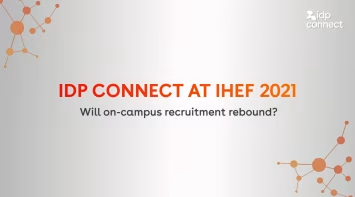This month our US team had an insightful conversation with Samira Pardanani, Associate Vice President for Student Services and International Education at Shoreline Community College in Washington. As a 25-year veteran in the international education field, Samira brings a wealth of experience and knowledge to the table. Here’s what she had to say about some of the more pressing topics of the day.

When reflecting on how the pandemic has affected your institution’s recruitment of international students, what has been your greatest success and greatest regret/frustration during this time?
The Covid-19 pandemic has been one of the biggest disruptors in the field of international education in my experience. It certainly upended any sense of “business as usual” when it comes to international recruitment. As such, even as things start returning to “normal”, we will never entirely go back to doing things the same way as we did back in 2019.
In terms of successes, the pandemic forced us to evolve, which we did. At Shoreline, the International Education department has always been innovative and agile, but Covid took us to a whole new level. The pandemic forced HEIs to not only change how we recruited students, but also the actual educational experience that we were offering students.
With regards to how we recruited, we paid particular attention to our overseas partners. They were as impacted as we were, if not more. We ramped up our communication and made sure to assure them that we would get through the challenging times together. When it came to both prospective and current students, we similarly prioritized communication. Almost overnight, our outreach team shifted from overseas in-person recruitment to virtual recruitment. It took some time to determine which virtual fairs were effective and which were less so, but we got better at it as time passed. Our team did so many middle-of-the-night fairs that they joked about having “domestic jetlag”. Given the constantly shifting external conditions, what was really important was for us to keep our ears firmly to the ground and monitor trends closely. Some unanticipated opportunities that the pandemic provided included unused travel funds that we were able to invest in a CRM. We were also able to diversify our recruitment much more in a virtual setting than we would normally have been able to do. In addition, we were able to involve alumni much more in our recruitment efforts in this virtual format.
With regards to frustrations, I think many colleagues in the field will be able to commiserate on the challenges that we faced. Students from our biggest market, China, were not eligible to get visas and were not crazy about online education. As the pandemic situation improved and travel opened up, recruitment travel now included many additional steps. This included needing to get special permission, having exit plans in place, having to book and re-book flights as conditions or rules changed, and of course, vaccination and testing requirements. One of our outreach team members went to Taiwan given the very low rates of infection. We had factored in a 2-week quarantine, but as luck would have it, soon after the quarantine was over, infection rates in the country started going up and they had to leave the country shortly thereafter.
How do you now recruit digitally and nurture those student leads through the admissions process?
We use search engine marketing/SEO, lead generation services, social media marketing, and virtual fairs/webinars. We also added 12 translated portals to our website that allow students/parents to read about our College in their native language, and IDP connect was a key strategic partner for this (note, we previously had translations, but they did not have the same level of dynamic content and back-end data that these portals do). We also have YouTube channels. Shortly after the pandemic arrived, we implemented a chat function on our website to allow prospective students another way of connecting with us.
When you look for new tools, research, methods to assist your planning moving forward, where do you turn?
We regularly attend NAFSA, the EducationUSA Forum, IACAC, etc. to make sure we are keeping up to date with all the trends and developments in the industry. This is especially important during these uncertain times. In terms of sources of data, IIE’s Open Doors report is of course an important source, particularly their mobility trends that are specific to community colleges. We also pay attention to state consortia data and meet with colleagues from peer institution.
Are you able to develop a strategic international enrollment management plan with all the uncertainty that exists? If so, what tips would you provide to help guide those eager to start?
Yes. I would say that it is even more important to have a SEM plan in these times. We used to do a SEM plan every 2-3 years. During the pandemic, it felt like we were having to review and tweak it every six months. It still helped in keeping us accountable and focused, as well as helping us to assess what was working and what was not. Additionally, having a plan in place is important to be able to advocate for support from institutional leadership and stakeholders.
For those who want to start, my advice would be to keep it simple, especially at the beginning. You want a plan that is easy to understand and easy to use. It is not something you want to keep on the shelf, so making sure that it is easy to understand and take action on is key.
When you think about the future of international education, what does it look like to you, 5 years, 10 years from now?
The speed and extent of recovery and further growth of the international education sector in the short term will depend on how quickly we come out of the pandemic, of course. We are already seeing substantial increases in applications and renewed interest from students. Removing as many barriers as possible will be important for institutions hoping to bring students back.
Long term, there are many reasons to be optimistic. While external conditions have been shifting, the basic value proposition remains largely intact, in my opinion. South Asia, especially India, has a very young population with high aspirations when it comes to education. This is also true of so many countries in Africa. The addition of online options is attractive in that students might decide to perhaps not come to the host country for their entire education, but for part of their education, which could be attractive in terms of cost effectiveness. Government policies of host countries can help tremendously. For example, improvements in visa issuance rates and fewer barriers would go a long way in bringing international students back. The same is true when it comes to post-study work opportunities. We are seeing hopeful signs of positive movement in this direction in the U.S., which will go a long way in reigniting international student interest in coming to our country to study.
You might like...

The World as Our Campus: Embracing a Holistic International Enrollment Strategy
An IDP 'Voice of the Sector' Piece

Peer-to-Peer: Why Student Ambassadors are Key Connections Throughout the Recruitment Funnel
A report from IDP and The Ambassador Platform

Advancing the National Conversation on International Education
IDP’s 2024 Think-Tank Event



